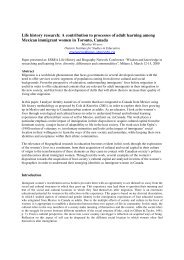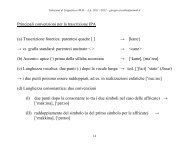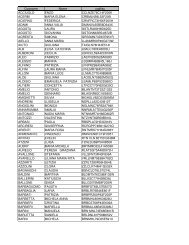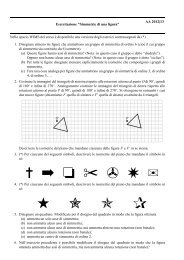La coda del pavone - Dipartimento di Scienze Umane per la ...
La coda del pavone - Dipartimento di Scienze Umane per la ...
La coda del pavone - Dipartimento di Scienze Umane per la ...
You also want an ePaper? Increase the reach of your titles
YUMPU automatically turns print PDFs into web optimized ePapers that Google loves.
merosi nomi <strong>di</strong> tribù, con re<strong>la</strong>tiva collocazione geografica, e <strong>per</strong><br />
alcuni <strong>di</strong> essi sono stati fatti tentativi <strong>di</strong> accostamento a nomi attuali. 5<br />
Ecco l’elenco <strong>di</strong> quelle ricordate da Erodoto:<br />
A. Nel<strong>la</strong> fascia costiera tra l’Egitto e l’attuale Tunisia.<br />
1. Gli Adyrmakhidai (Ἀδυρµαχίδαι dai confini <strong>del</strong>l’Egitto al porto <strong>di</strong><br />
Plynós (forse Si<strong>di</strong> Barrani o il golfo <strong>di</strong> Sollum) (IV, 168).<br />
2. I Giligamai (Γιλιγάµαι), dal porto <strong>di</strong> Plynos fino all’iso<strong>la</strong> <strong>di</strong><br />
Afro<strong>di</strong>siade (Isolotto <strong>di</strong> Chèrsa, a nord-est <strong>di</strong> Derna) (IV, 169).<br />
3. Gli Asbytai (Ἀσβύται o Ἀσβύσται), nell’entroterra <strong>di</strong> Cirene (IV,<br />
170), forse identificabili con gli ’sbtw citati da Ramesse III nel XII<br />
sec. a. C. e secondo Vycichl anche con gli Isәbәtәn, leggendari<br />
abitatori <strong>del</strong>l’Ahaggar prima <strong>del</strong>l’arrivo dei Tuareg <strong>del</strong> Nord.<br />
4. Gli Auskhisai (Αὐσχίσαι), tra l’altipiano <strong>di</strong> Barca e Bengasi (IV,<br />
171).<br />
5. I Kabales/Bakales (Κάβαλες o Βάκαλες), sul mare presso l’attuale<br />
Tocra (IV, 171).<br />
6. I Nasamones (Νασαµῶνες), pastori che noma<strong>di</strong>zzavano tra <strong>la</strong><br />
costa e l’oasi <strong>di</strong> Augi<strong>la</strong> (IV, 172; II, 31).<br />
7. Gli Psylloi (Ψύλλοι) che, partiti “in guerra contro il vento <strong>del</strong><br />
sud”, trovarono <strong>la</strong> morte nelle sabbie <strong>del</strong> deserto e furono rimpiazzati<br />
dai Nasamoni (IV, 173). 6<br />
8. I Makai (Μάκαι), più a occidente, sul<strong>la</strong> costa presso il fiume<br />
Kînyps, forse l’Oued Caam che sfocia tra Homs e Zliten (IV, 175).<br />
5 Per un elenco completo dei nomi <strong>di</strong> tribù ricordati dagli autori c<strong>la</strong>ssici, si<br />
veda Camps 1960.<br />
6 Per inquadrare questa strana notizia erodotea, può essere utile ricordare<br />
alcune storie facete, presenti ancor oggi nel<strong>la</strong> tra<strong>di</strong>zione orale, <strong>di</strong> presa in<br />
giro <strong>di</strong> tribù reali o immaginarie <strong>del</strong> passato: <strong>per</strong> esempio, dalle parti <strong>del</strong><br />
Rif, gli Ait Bchir che trovarono <strong>la</strong> morte “andando in caccia <strong>del</strong><strong>la</strong> nebbia,<br />
da essi creduta <strong>la</strong>na” o gli At Ameur, che cercarono <strong>di</strong> opporsi al<strong>la</strong> caduta <strong>di</strong><br />
un macigno restandone schiacciati uno dopo l’altro (Renisio 1932: 167,<br />
266)<br />
15

















